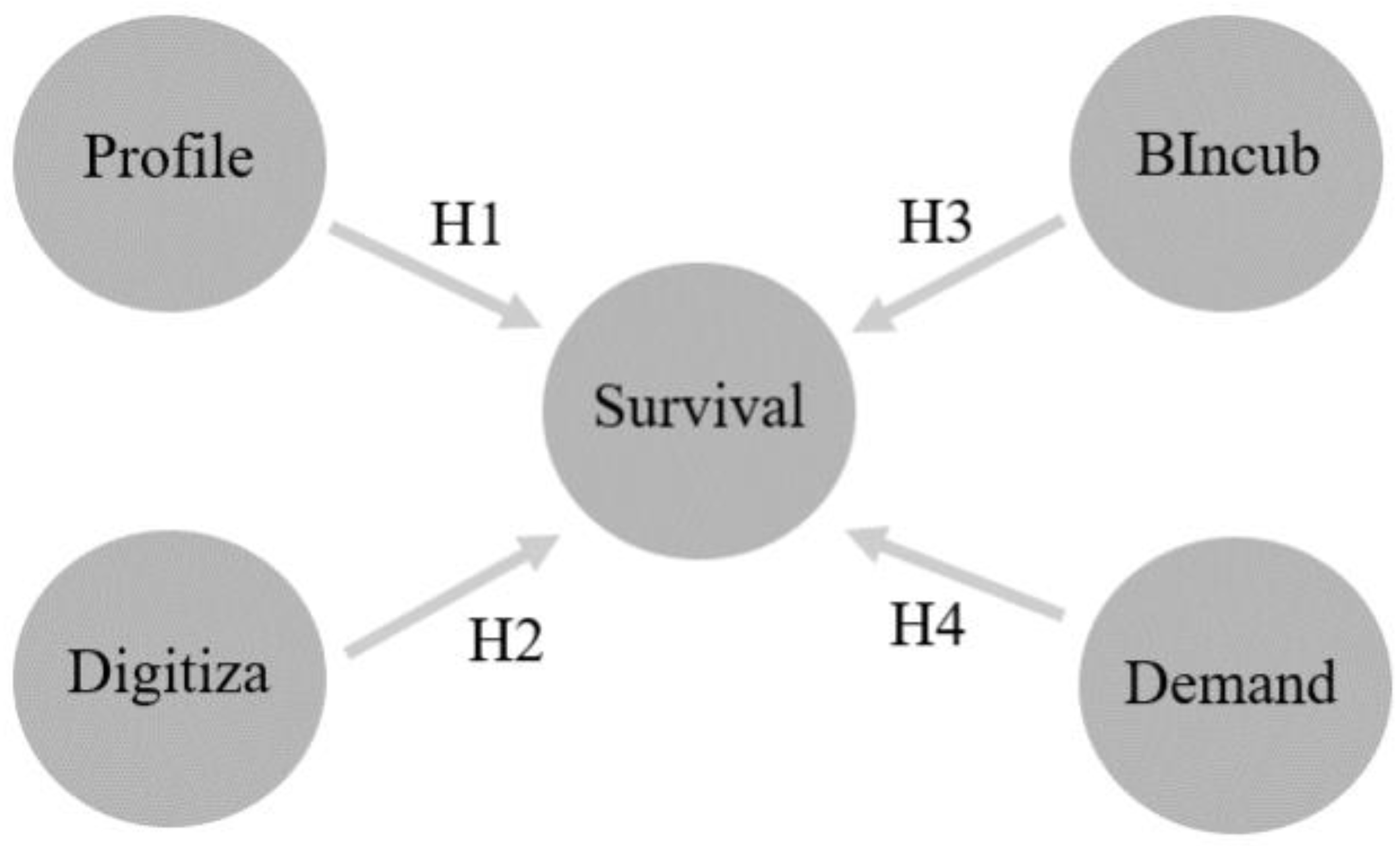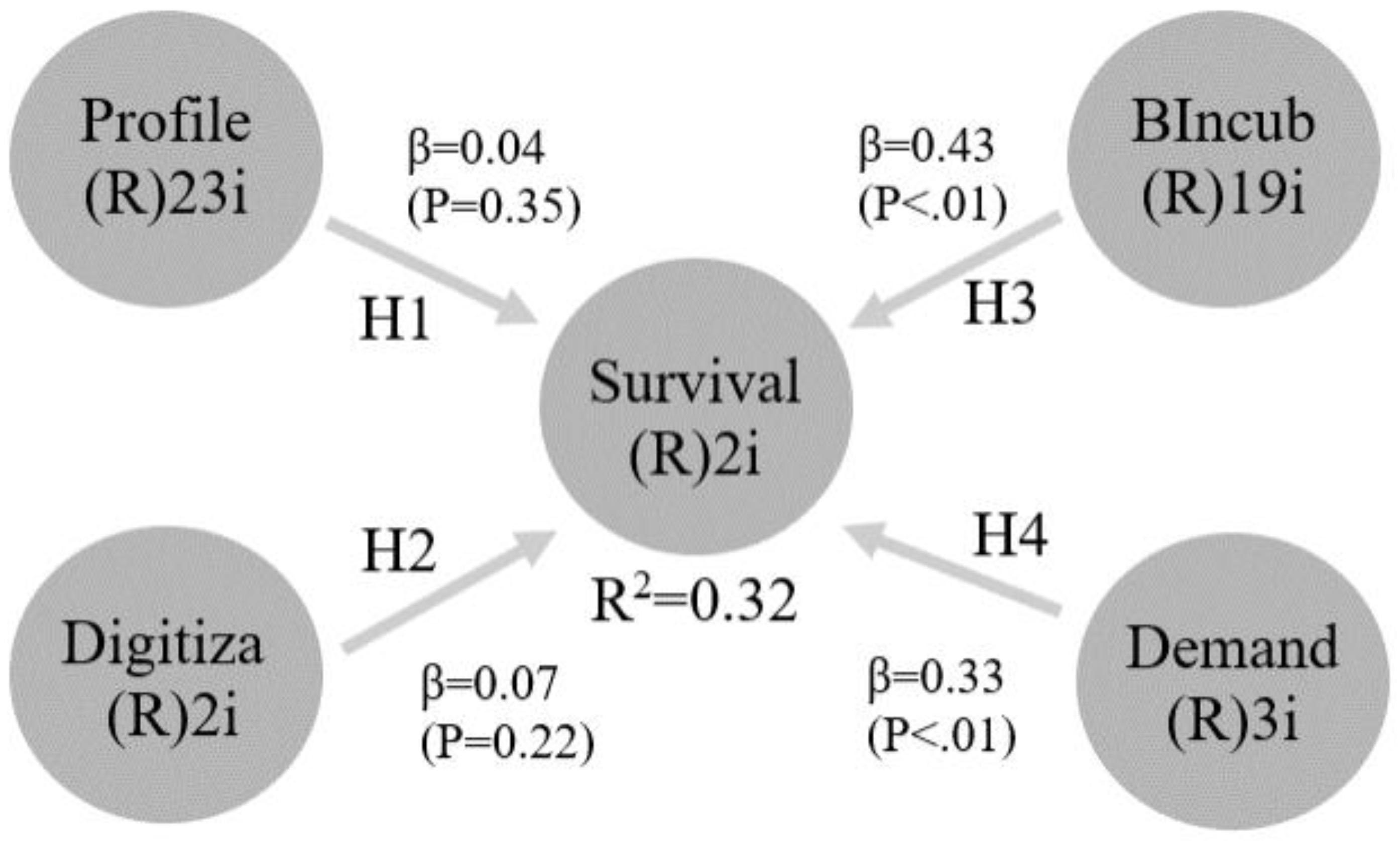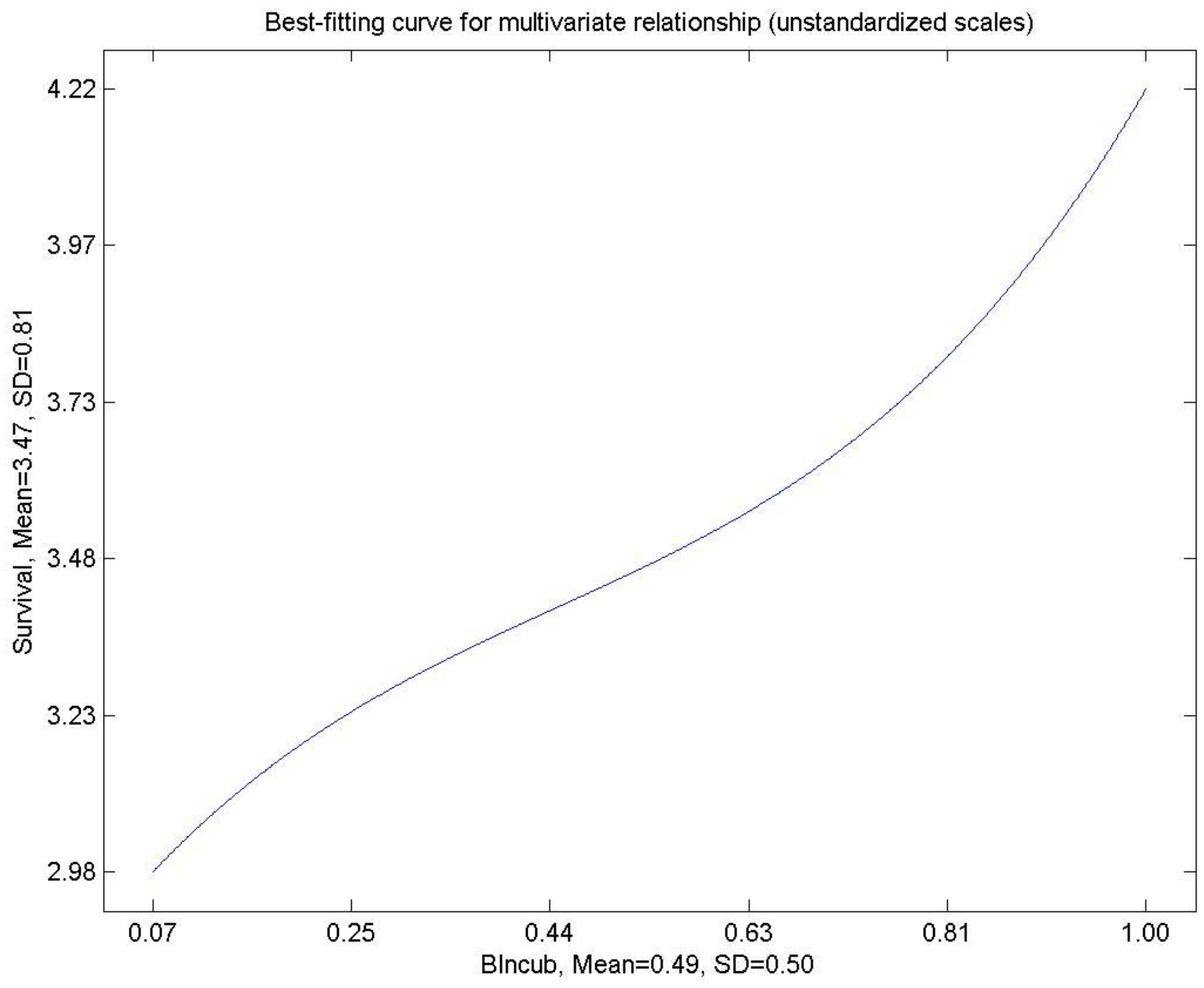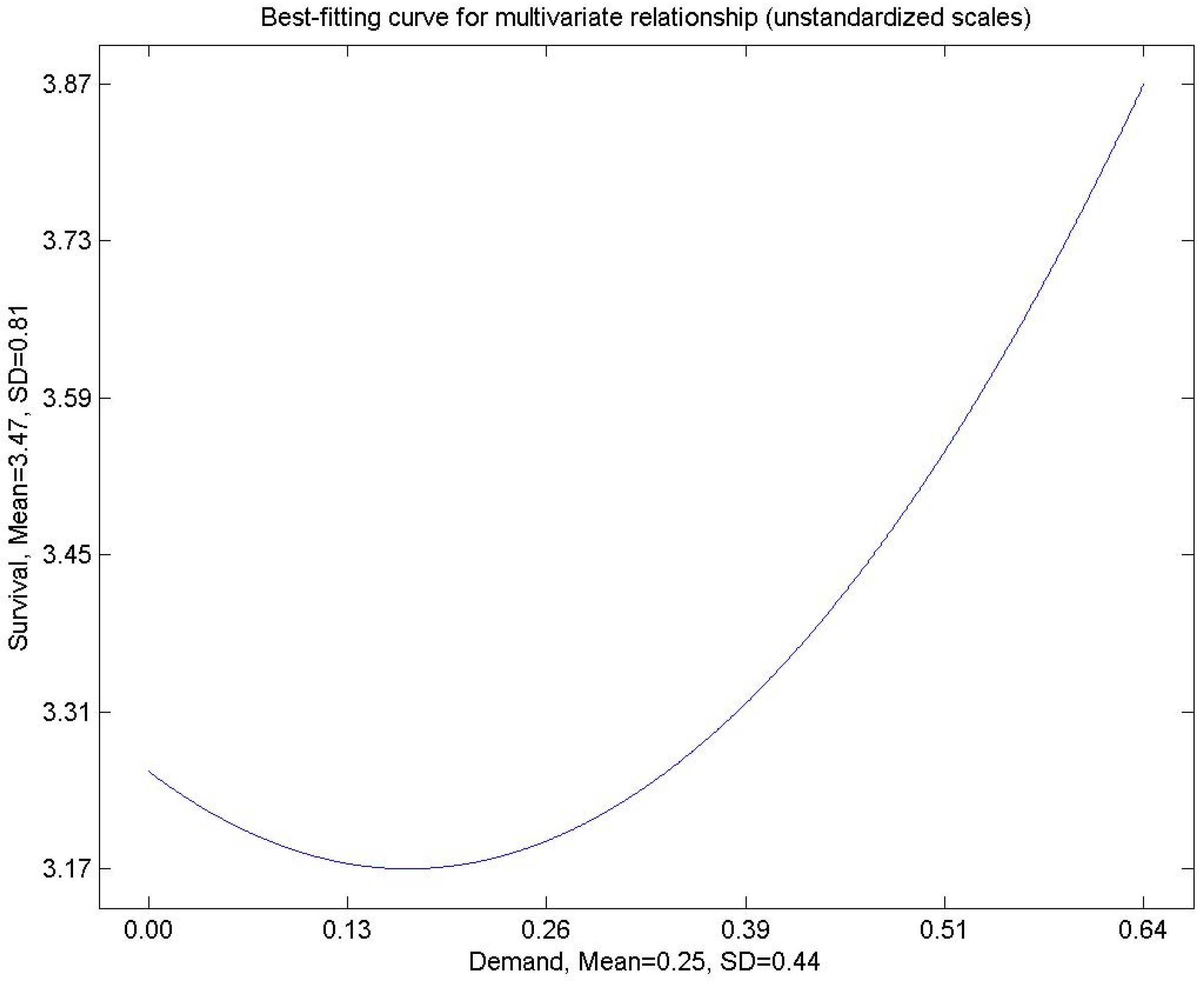Business Incubators and Survival of Startups in Times of COVID-19
Abstract
:1. Introduction
2. Materials and Methods
2.1. Hypotheses
2.2. The Sample
3. Results
4. Discussion
5. Conclusions
Author Contributions
Funding
Institutional Review Board Statement
Informed Consent Statement
Data Availability Statement
Acknowledgments
Conflicts of Interest
References
- Información Científica-Técnica. Enfermedad por Coronavirus, COVID-19; Gobierno de España, Ministerio de Sanidad: Madrid, Spain, 2021.
- Organización Mundial de la Salud. Available online: https://www.who.int/es/news/item/29-06-2020-covidtimeline (accessed on 12 September 2021).
- Real Decreto 463/2020, de 14 de Marzo, por el que se Declara el Estado de Alarma para la Gestión de la Situación de Crisis Sanitaria Ocasionada por el COVID-19. Ministerio de la Presidencia, Relaciones con las Cortes y Memoria Democrática 2020. Available online: https://www.boe.es/eli/es/rd/2020/03/14/463 (accessed on 15 December 2021).
- Statista. Available online: https://www.statista.com/topics/5994/the-coronavirus-disease-COVID-19-outbreak/ (accessed on 20 November 2021).
- Blanco, F.J.J.; Polo, C.G.O.; Fernández, M.T.F.; Santos, J.L.; de Esteban, D.E.; Asensio, A.C. Los Servicios que Prestan los Viveros y Aceleradoras de Empresas en España; Ranking 2021/2022; Funcas: Madrid, Spain, 2020. [Google Scholar]
- La COVID-19 y el Mundo del Trabajo. Estimaciones Actualizadas y Análisis; Organización Internacional del Trabajo: Geneve, Switzerland, 2020. [Google Scholar]
- Un Año Sin Igual. Informe anual del Fondo Monetario Internacional 2020. Available online: https://www.imf.org/external/pubs/ft/ar/2020/eng/downloads/imf-annual-report-2020-es.pdf (accessed on 16 December 2021).
- Meramveliotakis, G.; Manioudis, M. Sustainable Development, COVID-19 and Small Business in Greece: Small Is Not Beautiful. Adm. Sci. 2021, 11, 90. [Google Scholar] [CrossRef]
- Siuta-Tokarska, B. SMEs during the COVID-19 Pandemic Crisis. The Sources of Problems, the Effects of Changes, Applied Tools and Management Strategies—The Example of Poland. Sustainability 2021, 13, 10185. [Google Scholar] [CrossRef]
- Situación del Emprendimiento en España Ante la Crisis del COVID-19, Análisis y Recomendaciones; Asociación Observatorio del Emprendimiento de España (GEM): Madrid, Spain, 2020.
- Blanco, R.; Mayordomo, S.; Menéndez, P.A.; Mulino, M. El Impacto de la Crisis del COVID-19 Sobre la Situación Financiera de las Empresas no Financieras en 2020; Banco de España: Madrid, Spain, 2020. [Google Scholar]
- Mapa del Emprendimiento. South Summit Innovation Is Business 2020. Available online: https://ssassetspro.s3-eu-west-1.amazonaws.com/docs/MAPA+EMPRENDIMIENTO+2020.pdf (accessed on 16 December 2021).
- Global Entrepreneurship Monitor; Asociación Observatorio del Emprendimiento de España (GEM): Cantabria, Spain, 2020.
- Martínez, C.N.; Bañón, A.R. Emprendimiento en épocas de crisis: Un análisis exploratorio de los efectos de la COVID-19. Small Bus. Int. Rev. 2020, 4, 53–66. [Google Scholar] [CrossRef]
- Ferreiro-Seoane, F.J.; Mendoza, J.M.; Hernández-Carlzada, M.A. Contribution of the nurseries of Spanish companies in the labor market. Contad. Adm. 2019, 63. [Google Scholar] [CrossRef]
- Ramírez, J.P.G. Análisis de la Eficiencia de los Viveros de Empresas de la Comunidad de Madrid. Ph.D. Thesis, Departamento de Economía Aplicada I e Historia e Instituciones Económicas y Filosofía Moral, Facultad de Ciencias Jurídicas y Sociales, Universidad Rey Juan Carlos, Madrid, Spain, 2017. [Google Scholar]
- Bain & Company. Available online: https://www.bain.com/insights/now-that-we-know-remote-works-whats-next/ (accessed on 20 October 2021).
- Europa Press. 2020. Available online: https://www.elconfidencial.com/alma-corazon-vida/2020-05-07/casi-el-70-de-trabajadores-espanoles-dice-ser-igual-o-mas-productivo-trabajando-en-remoto-segun-un-estudio_2584612/ (accessed on 15 December 2021).
- Faraj, S.; Renno, W.; Bhardwaj, A. Unto the breach: What the COVID-19 pandemic exposes about digitalization. Inf. Organ. 2021, 31, 100337. [Google Scholar] [CrossRef]
- Donthu, N.; Gustafsson, A. Effects of COVID-19 on business and research. J. Bus. Res. 2020, 117, 284–289. [Google Scholar] [CrossRef] [PubMed]
- Cifras PYME. Gobierno de España 2020. Available online: http://www.ipyme.org/es-ES/ApWeb/EstadisticasPYME/Documents/CifrasPYME-marzo2020.pdf (accessed on 14 December 2021).
- Small and Medium Enterprises Finance. Banco Mundial. 2020. Available online: https://www.worldbank.org/en/topic/smefinance (accessed on 15 December 2021).
- Marco Estratégico en Política de PYME 2030. Informe de Seguimiento Anual 2020; Dirección General de Industria y de la Pequeña y Mediana Empresa, Gobierno de España: Madrid, Spain, 2021.
- Ratten, V. COVID-19 and entrepreneurship: Future research directions. Strat. Chang. 2021, 30, 91–98. [Google Scholar] [CrossRef]
- Jones, O.; Meckel, P.; Taylor, D. Situated learning in a business incubator: Encouraging students to become real entrepreneurs. Ind. High. Educ. 2021, 35, 367–383. [Google Scholar] [CrossRef]
- Weele, M.V.; Rijnsoever, F.J.V.; Nauta, F. You can’t always get what you want: How entrepreneur’s perceived resource needs affect the incubator’s assertiveness. Technovation 2017, 59, 18–33. [Google Scholar] [CrossRef] [Green Version]
- Bergek, A.; Norman, C. Incubator best practice: A framework. Technovation 2008, 28, 20–28. [Google Scholar] [CrossRef] [Green Version]
- Galbraith, B.; McAdam, R.; Cross, S.E. The Evolution of the Incubator: Past, Present, and Future. IEEE Trans. Eng. Manag. 2021, 68, 265–271. [Google Scholar] [CrossRef]
- Lin, C.L.; De-Pablos-Heredero, C.; Montes-Botella, J.L. Value creation of business incubator functions: Economic and social sustainability in the COVID-19 scenario. Sustainability 2021, 13, 6888. [Google Scholar] [CrossRef]
- De Esteban, D.E. Relational coordination in the entrepreneurial ecosystem. Esic Market Econ. Bus. J. 2020, 51. [Google Scholar] [CrossRef]
- Schwartz, M. A control group study of incubators’ impact to promote firm survival. J. Technol. Transf. 2013, 38, 302–331. [Google Scholar] [CrossRef] [Green Version]
- Buddelmeyer, H.; Jensen, P.; Webster, E. Innovation and the determinants of company survival. Oxf. Econ. Pap. 2010, 62, 261–285. [Google Scholar] [CrossRef]
- Motohashi, K. University–industry collaborations in Japan: The role of new technology-based firms in transforming the National Innovation System. Res. Policy 2005, 34, 583–594. [Google Scholar] [CrossRef]
- Mas-Verdú, F.; Soriano, D.R.; Roig-Tierno, N. Firm survival: The role of incubators and business characteristics. J. Bus. Res. 2015, 68, 793–796. [Google Scholar] [CrossRef]
- Segura, F.M. El perfil emprendedor y la intensidad competitiva del mercado como predictores de supervivencia en microempresas mexicanas. Contad. Adm. 2019, 65, 1–27. [Google Scholar] [CrossRef]
- García, C.R. Factores de Supervivencia Empresarial: Análisis Desde la Perspectiva del Éxito y Fracaso. Ph.D. Thesis, Departamento de Organización de Empresa, Facultad de Ciencias Económicas y Empresariales, Universidad de León, León, Spain, 2015. [Google Scholar]
- Gutiérrez, W.R.; Sepúlveda, C.I.R.; González, G.J.U. Análisis semiparamétrico de los factores asociados a la sostenibilidad de los emprendimientos. Rev. Fac. Cienc. Econ. 2016, XXVI, 163–180. [Google Scholar] [CrossRef] [Green Version]
- Carneiro, A.V.R.; Amorim, C.V. Entry and exit dynamics of nascent business owners. Small Bus. Econ. 2015, 45, 63–84. [Google Scholar]
- Staniewski, M.W.; Janowski, K.; Awruk, K. Entrepreneurial personality dispositions and selected indicators of company functioning. J. Bus. Res. 2016, 69, 1939–1943. [Google Scholar] [CrossRef]
- Ligthelm, A. Survival Analysis of Small Informal Businesses in South Africa, 2007–2010. Eurasian Bus. Rev. 2011, 1, 160–179. [Google Scholar]
- Hassani, H.; Huang, X.; Silva, E. The Human Digitalisation Journey: Technology First at the Expense of Humans? Information 2021, 12, 267. [Google Scholar] [CrossRef]
- Guo, H.; Yang, Z.; Huang, R.; Guo, A. The digitalization and public crisis responses of small and medium enterprises: Implications from a COVID-19 survey. Front. Bus. Res. China 2020, 14, 19. [Google Scholar] [CrossRef]
- Bokolo, A.J.; Petersen, S.A. Examining the digitalization of virtual enterprises amidst the COVID-19 pandemic: A systematic and meta-analysis. Enterp. Inf. Syst. 2021, 15, 617–650. [Google Scholar]
- Blank, T.H. When incubator resources are crucial: Survival chances of student startups operating in an academic incubator. J. Technol. Transf. 2020, 46, 1845–1868. [Google Scholar] [CrossRef]
- Bernasconi, E.S. Innovación y Competitividad Empresarial. Ph.D. Thesis, Departamento de Gestión de Empresas, Facultad de Ciencias Económicas y Empresariales, Universitat Rovira I Virgili, Tarragona, Spain, 2015. [Google Scholar]
- Del Campo Villares, M.O.; Miguéns-Refojo, V.; Ferreiro-Seoane, F.J. Business Survival and the Influence of Innovation on Entrepreneurs in Business Incubators. Sustainability 2020, 12, 6197. [Google Scholar] [CrossRef]
- Zapata-Guerrero, F.T.; Ayup, J.; Granados, E.L.M.; Charles-Coll, J. Incubator efficiency vs survival of start-ups. RAUSP Manag. J. 2020, 55, 511–530. [Google Scholar] [CrossRef]
- Hoda, S.; Singh, A.; Rao, A.; Ural, R.; Hodson, N. Consumer demand modeling during COVID-19 pandemic. In Proceedings of the 2020 IEEE International Conference on Bioinformatics and Biomedicine (BIBM), Seoul, Korea, 16–19 December 2020; pp. 2282–2289. [Google Scholar]
- Leach, M.; MacGregor, H.; Scoones, I.; Wilkinson, A. Post-pandemic transformations: How and why COVID-19 requires us to rethink development. World Dev. 2021, 138, 105233. [Google Scholar] [CrossRef]
- Veselovská, L.; Závadský, J.; Bartková, L. Consumer Behaviour Changes during Times of the COVID-19 Pandemic: An Empirical Study on Slovak Consumers. E+M Ekon. Manag. 2021, 24, 136–152. [Google Scholar] [CrossRef]
- Miescu, M.; Rossi, R. COVID-19-induced shocks and uncertainty. Eur. Econ. Rev. 2021, 139, 103893. [Google Scholar] [CrossRef]
- Bouza, C. Encuestas Por Muestreo y Sus Principios. Desafíos de la Actualidad en la Valoración de Competitividad, Desarrollo, Bienestar e Innovación Social para la Investigación. Academia Accelerating the World’s Research 2020. Available online: https://www.academia.edu/43707041/ENCUESTAS_POR_MUESTREO_Y_SUS_PRINCIPIOS?from=cover_page (accessed on 15 December 2021).
- Manzano, P.A.P. Introducción a los modelos de ecuaciones estructurales. Investig. Educ. Med. 2017, 7, 67–72. [Google Scholar]
- Martínez, A.M.; Fierro, M.E. Application of the PLS-SEM technique in Knowledge Management: A practical technical approach. Rev. Iberoam. Investig. Desarro. 2018, 8, 130–164. [Google Scholar]
- Jöreskog, K.G.; Wold, H. (Eds.) The ML and PLS techniques for modeling with latent variables: Historical and comparative aspects. In Systems under Indirect Observation; Elsevier: Amsterdam, The Netherlands, 1982; Volume 8, pp. 263–270. [Google Scholar]
- Chin, W.; Cheah, J.-H.; Liu, Y.; Ting, H.; Lim, X.-J.; Cham, T.H. Demystifying the role of causal-predictive modeling using partial least squares structural equation modeling in information systems research. Ind. Manag. Data Syst. 2020, 120, 2161–2209. [Google Scholar] [CrossRef]
- Chin, W.W. The partial least squares approach to structural equation modeling. In Modern Methods for Business Research; Marcoulides, G.A., Ed.; Erlbaum: Mahwah, NJ, USA, 1998; pp. 295–358. [Google Scholar]
- Hair, J.F.; Sarstedt, M. Composites vs. factors: Implications for choosing the Right SEM method. Proj. Manag. J. 2019, 50, 1–6. [Google Scholar] [CrossRef]
- Nitzl, C.; Chin, W.W. The case of partial least squares (PLS) path modeling in managerial accounting research. J. Manag. Control 2017, 28, 137–156. [Google Scholar] [CrossRef]
- Tenenhaus, M.; Esposito, V.V.; Chatelin, Y.M.; Lauro, C. PLS path modeling. Comp. Stat. Data Anal. 2005, 48, 159–205. [Google Scholar] [CrossRef]
- Wold, H. Partial least squares. In Encyclopedia of Statistical Sciences; Kotz, S., Johnson, N.L., Eds.; Wiley: New York, NY, USA, 1985; pp. 581–591. [Google Scholar]
- COVID-19: The Great Lockdown and Its Impacto on Small Business. SME Competitivenes Outlook 2020. International Trade Centre 2020. Available online: https://www.intracen.org/uploadedFiles/intracenorg/Content/Publications/ITC_SMECO-2020ExSummary_EN_web.pdf (accessed on 15 December 2021).
- Impacto Económico de la COVID-19 Sobre la PYME en España, Informe PYME 2021. 2021. Available online: https://www.camara.es/sites/default/files/publicaciones/informe_pyme_2021._impacto_economico_de_la_covid-19_sobre_la_pyme_en_espana.pdf (accessed on 16 December 2021).
- Ptak-Chmielewska, A. Entrepreneurs: Demographic Profile, who has Higher Chances of Survival? In Proceedings of the International Conference on e-Learning, Proceedings of the 2nd International Conference on Innovation and Entrepreneurship (ICIE-2014), Bangkok, Thailand, 6–7 February 2014; Ribiere, V., Worasinchai, L., Eds.; pp. 209–216. [Google Scholar]
- Albort-Morant, G.; Oghazi, O. How useful are incubators for new entrepreneurs? J. Bus. Res. 2016, 69, 2125–2129. [Google Scholar] [CrossRef]
- Crittenden, A.B.; Crittenden, V.L.; Crittenden, W.F. The digitalization triumvirate: How incumbents survive. Bus. Horizons 2019, 62, 259–266. [Google Scholar] [CrossRef]
- Soto-Acosta, P. COVID-19 Pandemic: Shifting Digital Transformation to a High-Speed Gear. Inf. Syst. Manag. 2020, 37, 260–266. [Google Scholar] [CrossRef]
- Bandrés-Goldáraz, E.; Conde-Casado, M.; Iniesta-Alemán, I. The impact of COVID-19 in small and medium-sized communication enterprises in Spain. J. Adm. Econ. Sci. 2021, 11, 25–40. [Google Scholar]





| Date | Number of Answers Coming from Entrepreneurs | Description | |
|---|---|---|---|
| Search of entrepreneurs | From September 2020 to January 2021 | 809 | A web and telephone search are made of all possible entrepreneurs located in Madrid |
| Building of the sample and the survey | From January 2021 to February 2021 | - | The sample is improved by searching for all the contact details of the entrepreneurs to make the sending of the questionnaire accurate |
| Online publication of the survey | February 2021 | 104 | The web questionnaire is published, and the link is sent to all the sample of the entrepreneurs |
| Phone contact | From February 2021 to May 2021 | 104 | A reminder is given to the collection of answers by telephone calls to the whole sample |
| Factor of Analysis | Description |
|---|---|
| Entrepreneur profile | Location of the firm Age of the firm Gender of the promoter team Age of the entrepreneur Branch of studies of the promoter team Sector of activity Legal status |
| Digitization | Technology that has been most widely deployed during the pandemic |
| Impact of business incubators | Whether they are currently benefiting from the services in a business incubator, and to what extent this has helped the company to survive the COVID-19 crisis Aids offered by business incubators to mitigate the damage of the crisis Perception on whether business incubators have been fundamental for the survival of the entrepreneur in times of COVID-19 Impact of COVID-19 on the current business situation |
| Fluctuations in demand | If the activity continues, to what extent was the demand for its products or services affected, whether it has remained constant, decreased, or increased. |
| Average path coefficient (APC) = 0.218, p = 0.005 |
| Average R-squared (ARS) = 0.321, p < 0.001 |
| Average adjusted R-squared (AARS) = 0.294, p < 0.001 |
| Average block VIF (AVIF) = 1.061, acceptable if <= 5, ideally <= 3.3 |
| Average full collinearity VIF (AFVIF) = 1.264, acceptable if <= 5, ideally <= 3.3 |
| Tenenhaus GoF (GoF) = 0.366, small >= 0.1, medium >= 0.25, large >= 0.36 |
| Sympson’s paradox ratio (SPR) = 0.750, acceptable if >= 0.7, ideally = 1 |
| R-squared contribution ratio (RSCR) = 0.987, acceptable if >= 0.9, ideally = 1 |
| Statistical suppression ratio (SSR) = 1.000, acceptable if >= 0.7 |
| Nonlinear bivariate causality direction ratio (NLBCDR) = 1.000, acceptable if >= 0.7 |
Publisher’s Note: MDPI stays neutral with regard to jurisdictional claims in published maps and institutional affiliations. |
© 2022 by the authors. Licensee MDPI, Basel, Switzerland. This article is an open access article distributed under the terms and conditions of the Creative Commons Attribution (CC BY) license (https://creativecommons.org/licenses/by/4.0/).
Share and Cite
De Esteban Escobar, D.; De-Pablos-Heredero, C.; Montes-Botella, J.L.; Blanco Jiménez, F.J.; García, A. Business Incubators and Survival of Startups in Times of COVID-19. Sustainability 2022, 14, 2139. https://doi.org/10.3390/su14042139
De Esteban Escobar D, De-Pablos-Heredero C, Montes-Botella JL, Blanco Jiménez FJ, García A. Business Incubators and Survival of Startups in Times of COVID-19. Sustainability. 2022; 14(4):2139. https://doi.org/10.3390/su14042139
Chicago/Turabian StyleDe Esteban Escobar, Débora, Carmen De-Pablos-Heredero, José Luis Montes-Botella, Francisco José Blanco Jiménez, and Antón García. 2022. "Business Incubators and Survival of Startups in Times of COVID-19" Sustainability 14, no. 4: 2139. https://doi.org/10.3390/su14042139
APA StyleDe Esteban Escobar, D., De-Pablos-Heredero, C., Montes-Botella, J. L., Blanco Jiménez, F. J., & García, A. (2022). Business Incubators and Survival of Startups in Times of COVID-19. Sustainability, 14(4), 2139. https://doi.org/10.3390/su14042139








